Wed 7 Jul 2010
A Review by David L. Vineyard: SUSAN HILL – The Woman in Black.
Posted by Steve under Reviews[9] Comments
SUSAN HILL – The Woman in Black. David R Godine, hardcover,1986; trade paperback, November 1987. Originally published by Hamish Hamilton, UK, hardcover, 1983. Many later reprint editions.
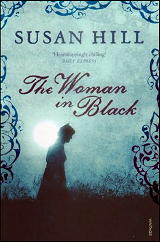
It is Christmas, and solicitor Arthur Kipps’ family is clamoring for a Christmas ghost story, but he has no intention of sharing one, for the one ghost story Mr. Kipps knows is no tale for a cozy fire and a family setting …
The detective story and the ghost story as we know it both have a common ancestry in the birth of the Romantic Movement and the Gothic tale that developed as part of it, then morphed into the detective story on one hand and science fiction and fantasy on the other.
In particular, though, the ghost story has always had some appeal to many of the readers and writers of detective fiction, as if in the urge to explain away the world in terms of rational thought, there was also a desire to recapture the innocence of simple faith in the uncanny and the unnatural. That, and the ghost story often has a mystery to be solved at its heart, the mystery of why the ghost haunts in the first place.
There is a long list of psychic sleuths and no small number of writers of detective fiction who have dabbled in the supernatural including names such as Edgar Allan Poe, Joseph Le Fanu, Sir Arthur Conan Doyle, Dorothy L. Sayers, Dashiell Hammett, Raymond Chandler, Cornell Woolrich, John Dickson Carr, and many more — sometimes in standalone tales of the supernatural and in others in combination with the detective story. Even Barzun and Taylor included a section of ghost stories in their Catalogue of Crime.
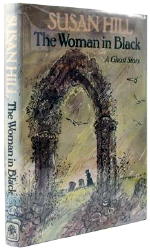
And don’t forget that Sherlock Holmes, that most rational of rational thinkers, encountered a spectral hound, a vampire, and off the page, a mix of giant Sumatran rodents and worms unknown to science — and even when he and others explain away the supernatural, the faintest hint often lingers on the edge of the reader’s perception.
A handful of stories like Carr’s The Burning Court and Helen McCloy’s Through a Glass Darkly manage the neat twist of having it both ways, what Frank D. Sherry called the “Janus Solution,” both a rational solution and a supernatural one.
Susan Hill’s The Woman in Black is not only a ghost story, it appeared as a young adult novel originally, but for anyone who reads it the memory will linger. It is an exceptionally dark and powerful book. This is no Janus solution though. This is a full blown ghost story, and unrepentantly so.
Mrs. Alice Drablow of Eel Marsh House has died, and young solicitor Arthur Kipps is chosen by his employer Mr. Bentley to travel to the north of England, attend Mrs. Drablow’s funeral, and see to her estate. It’s an important assignment for Kipps and a chance for promotion so he can marry his fiancee Stella.
But rumors abound about Eel Marsh House, and as Kipps is taken in a pony cart across the dangerous marshes to visit the place he is struck by its unique appearance.
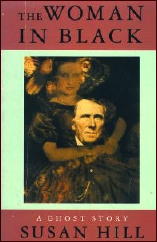
As in the modern gothic, houses are often virtually characters in many ghost stories. Here Eel Marsh House plays that role.
There he sees for the second time a mysterious and curiously malign woman in black he first spied at Mrs. Drablow’s funeral. He also experiences a terrifying experience of a woman and child killed on the marsh in a pony trap — or thinks he does, the mist is on the marsh and he can hear the tragedy, but not see it. But no such accident or missing persons are reported.
Doing a bit of detective work, he begins to piece together the story of Eel Marsh House together from the reluctant locals. No one wants to talk about Eel Marsh House, or the woman in black. Borrowing a dog for a companion from the landlord he is staying with, Kipps returns to Eel Marsh House to complete his inventory.
Gradually he learns of the tragedy that occurred at Eel Marsh House. A young woman and a child drowned in the marsh in a pony trap and their fate was tied to the death of a spinster woman who lived there, Jennet Humpfrye, who became obsessed with her sister Alice Drablow’s child and blamed her sister for the accident in which the child and a servant were killed in a pony trap on the marsh — in circumstances much like those Kipps experienced his first time alone in the mist.
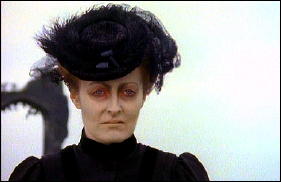
Jennet Humpfrye is the woman in black, who, suffering a wasting disease, went mad in her grief for the child that was not hers — went mad and lingered on to take her revenge beyond the grave.
Again Kipps hears the crying of he dying child and the screaming woman on the marsh — and the dog hears it too, and he and the dog both almost lose their lives on the treacherous marsh as the woman in black watches them struggle and almost drown. Mr. Dailey, he landlord, arrives in time to take Kipps and the dog away, and reveal the final secrets of Eel Marsh House.
After his near death, Kipps’ health fails and he is haunted by the woman in black; his fiancee Stella comes to fetch him back to London when his fever breaks and away from Eel Marsh House and the malignant spirit of Jennet Humpfrye.
But neither she nor Eel Marsh House is finished with Kipps or us. Wherever Jennet Humpfrye has been seen there has been one “sure and certain result,” as Kipps learns from Mr. Dailey; “in some violent circumstance a child has died.” Time passes, Kipps and Stella marry, and they have a son …
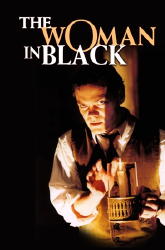
The Woman in Black was highly acclaimed on publication, and is now considered a modern classic of the form. It has rightly been called a ghost story as Jane Austen might have written one. Like most such tales, it depends on an accumulation of tensions, small disturbances, and sudden shocks, and though a short novel, barely 50,000 words, it has the weight of a much longer tome.
A fully dramatized version of The Woman in Black was recently aired on BBC7 (it first aired in the 1990’s) adapted by John Strickland in four parts with John Woodvine as the older Kipps. It was adapted for television in 1989 with a teleplay by Nigel Kneale (the Quatermass serials and films) and directed by Herbert Wise.
Like the best of ghost stories, this one is simple, quiet, and builds to a moment of power and tragedy. Though it certainly has its moments of terror — Kipps lost on the marsh in a mist listening helplessly as a woman and child die in terror; a chair rocking in a closed room; the malevolent appearance of the title character; his near death on the marsh with the dog, Spider, lent him by the landlord of the inn; and his final confrontation with the woman in black — it is not about sudden frights or bloodshed.
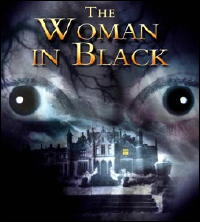
There is no gore and no monster — only a terrible grief that leads to otherworldly revenge, and one man’s encounter with things that cannot be rationally explained — or dismissed.
They have asked for my story. I have told it. Enough.
July 8th, 2010 at 1:16 am
I understand the film changed the ending of the book? It’s quite an effective film, I think, though the ending really laid it on strong!
The Golden Age of detective fiction was also the Golden Age of the ghost story. Interesting that, given that the detective story is ostensibly about the restoration of order while the ghost story often undermines it. But both, as you say, involve the explication of riddles.
July 8th, 2010 at 2:57 am
The detective story is often about the restoration of order out of chaos whereas the supernatural tale more often acknowledges that such efforts are futile (curiously in this the hard boiled detective story has some relation to the ghost story though the chaos is of human making), but it is curious how often the ghost story in particular mocks and mimics the detective story in form and function.
Certainly the governess in Henry James TURN OF THE SCREW, the scientists in Shirley Jackson’s THE HAUNTING OF HILL HOUSE and Richard Matheson’s THE LEGEND OF HELL HOUSE, the hero and his sister in THE UNIVITED (DARK FREEHOLD), the Wodehousian heroes of some of Charles Jackson’s religious thrillers who would be at home in Christie, Sayers, or Allingham novels of the twenties and thirties, and some of the psychic sleuths that abound in supernatural fiction employ the methods of not only detectives, but Golden Age detectives, as they pursue the mystery that lies at the core of a haunting.
Though a supernatural tale and not a ghost story the protagonists of DRACULA marshal all the trappings of the burgeoning new century to pursue and battle ancient evil adding to their cache of wooden stakes, Bowie knives, holy water, and blessed wafers steamships, trains, mass communication, dictaphones, psychology, typewriters, Winchester rifles, and even a pseudo scientific explanation of vampirism itself to defeat Dracula.
But unlike the detective story the solution to the mystery does not restore order — even when the ghost in question is laid — but opens the characters and the reader to deeper mysteries and the chaotic nature of the universe. Only rarely does a detective story leave you more ill at ease when you have finished than when you began (Cornell Woolrich and Patricia Highsmith were masters at this aspect of suspense fiction), but that is the goal of the ghost story.
I think the detective story and the ghost story are two sides of the same coin; both reactions to the materialistic and scientific advances of the Victorian age. The detective story suggests the triumph of rational thought and scientific method over the often irrational side of human nature, while the ghost story reminds us, that as in Quantum Theory, there is an imp of the perverse undermining our cool rational sides and we are still prey to that atavistic nature of man that the Victorian’s like Doyle and Stevenson were both fascinated and repelled by.
But the two are yoked together, and if they seem to be pulling in different directions it is often an illusion. A fair number of writers of the Golden Age — including Detection Club members — penned a supernatural tale or two or at least like Agatha Christie in her Harly Quin stories suggested the supernatural. Chesterton’s Father Brown and his Gabriel Gale both have almost supernatural powers at times even when providing a rational explanation for the bizarre. Carr is addicted to Gothic trappings and manages the neat trick of having it both ways — the shudder or frisson and the cool rational explanation — that still doesn’t dissipate the shudder and frisson — even amid the slapstick and comedy of some books.
And curiously as the detective story became more literate and more serious you see in writers as diverse as Dorothy L. Sayers, Ellery Queen, Dashiell Hammett, John D. MacDonald, and Ross Macdonald a recognition that the solution of the mystery does not really restore order, but often leaves behind as much chaos as the crime itself — which is essential to the ghost story — the idea that having laid one mystery you only open yourself to a deeper one that cannot be laid — this side of the grave.
There is a line of Thomas Hardy’s, from TWO IN A TOWER, “… there are things more terrible than monsters of shape, namely, monsters of magnitude without known shape.” The detective story tries to give those ‘monsters of magnitude’ a shape and reassure us they are, after all, only spirits dispelled by the light of reason: the ghost story undermines that reassurance by reminding us that for all man’s achievements of rational thought and scientific advancement he is still the pawn of forces he can neither control or perhaps adequately explain.
Even in the most rational and scientific of detective stories there is always the unspoken recognition that having laid the ghost of unreason and the demons of chaos the victory is only temporary and incomplete until the next foray of the irrational into our ordered little world.
The bright sun may be bathing everything in light and warmth for the time being, but dark clouds and shrouded fogs will soon enough blur the lines and have to be dispelled by reason and rational thought. Even Dr, Thorndyke, with his test tubes and chemicals, can’t come up with a formula to change human nature. Like the ghost story the detective story is haunted — by man’s own nature and natures as yet unexplained — if not inexplicable — mysteries.
July 8th, 2010 at 6:25 am
My wife & I have seen this as a play twice. It’s done on a mostly-bare stage with a few props (2 chairs, a trunk that is sometimes a desk, sometimes a carriage seat, a few coats & hats for costumes…) and 2 actors. Once your imagination gets going, you really get into the thing. Late in the action, there’s a scene where a dog gets trapped in quicksand and the actor tries to pull it out. Now there’s no dog, and certainly no quicksand; just an actor at the edge of the stage pretending to pull on a collar, but everyone in the theatre is yelling, “GET THE DOG! GET THE DOG!!!” Wonderful stuff!
July 8th, 2010 at 10:09 am
What can I say but…tastes differ. We saw this in London 8 years ago and didn’t care for it at all.
Or maybe we just weren’t in the mood that night.
July 8th, 2010 at 11:16 am
It’s funny Dan, I had the same reaction to the radio play — GET THE DOG! But then I’ll grant I’m one of those people who don’t care how many people die in a film or play if the pets make it out safe. Not heartless, just sentimental.
To heck with Roddy MacDowall, save Lassie!
And a ghost story is ideal for such experimental — or at least minimalist — theater, since so much of the effect depends on the mind of the audience. Similarly there has been a hit version of THE 39 STEPS in London and on Broadway which uses a handful of actors, simple costumes, and the imagination of the audience effectively. You have to wonder how Robert Towne’s big budget upcoming screen version will do in comparison.
But as Jeff says, you may have to be in a receptive mood.
THE WOMAN IN BLACK is ideal for such a treatment since so much of the effectiveness of the book depends on the identification with the narrator who is presented as an intelligent likable and wholly innocent figure confronted by irrational evil he can neither escape nor defeat.
Susan Hill, I should point out is also the author of the Simon Serralier crime novel series about a policeman in Lafferton, a fictional Cathedral town in the South of England. There are five books so far in the series including the award winning VOWS OF SILENCE, PURE IN HEART, RISK OF DARKNESS, SHADOWS IN THE STREET, and THE SIMON SERRAILIER COMPANION. Hill describes them as crime novels saying she can’t write a detective story.
Her other ghost stories include THE MIST IN THE MIRROR, THE MAN IN THE PICTURE, and THE SMALL HAND. It’s no real surprise to learn her chief influences as a writer of ghost stories were M.R.James and Daphne Du Maurier.
July 8th, 2010 at 1:11 pm
It’s been a busy week for me, so thanks, David, for telling us something about Hill’s Simon Serralier series. I’ve been meaning to look into them, and I just haven’t had time. I’ve never seen one, so anything I learn about the series is new to me.
And speaking of Daphne du Maurier, as you did just now, you neglected to mention that Susan Hill is also the author of MRS. DE WINTER, a sequel to REBECCA, written by everyone knows who.
— Steve
July 8th, 2010 at 1:55 pm
Steve
I completely forgot MRS. DE WINTER — a misfire, but a noble one as I recall. I haven’t read any of her Simon Serralier books either, but I plan to now. All I know of the series is what is said on her site, but from that they sound intriguing, and she can certainly write. All but one of them can be purchased in paperback from her and shipped Surface Mail (about a month generally though it used to be six weeks).
She doesn’t mention MRS. DE WINTER at her site. Maybe she’d just as soon forget it.
According to the site the play of THE WOMAN IN BLACK has been running continuously since 1986 and a new film of the book is planned from the revived Hammer Studios.
July 8th, 2010 at 4:27 pm
I think more detective fiction writers than are realized came to portray more disordered worlds in the later part of the Golden Age. The whole restoration of order concept that is so popular today tends to be derived from Auden’s Guilty Vicarage essay, where he admitted up front the was writing about the sort of detective novel he most liked reading (village cozy).
Sayers tried to do this a bit, but with mixed results. It’s hard to feel much concern for the fates of the characters in The Documents in the Case, though Sayers clearly tried to invest more emotional interest in that book. Then there’s Harriet Vane. Strong Poison shows her going through some trauma, but by the end of her series with Lord Peter, she’s pretty much gotten everything a girl could want!
I continue to think Christie doesn’t get enough credit in this area. And Then There Were None is impressively bleak. There’s real pain in Five Little Pigs and The Hollow and there aren’t happy endings, really. Evan a book like Death on the Nile leaves us with mixed feelings at the end. I find these darker books than those from the 1930s and 1940s by the other Crime Queens, on the whole.
Henry Wade, whom I have a 110 page section on in my manuscript, is much under-credited in this respect.
Even genuine “Humdrums” like Street and Connington (by which I mean writers who emphasized puzzle decisively over other things and had less flair for characterization) wrote some books that were less reassuring as the Golden Age progressed.
So was Carr, with The Burning court, say (ghost story again), and She Died a Lady.
I think the above, plus the popularity of the ghost story, a form which can be very unsettling, somewhat challenges the idea that people in the Golden age were uniquely eager for books promoting “order.”
Even today, with all the serial killer books, we have a lot of people buying cozies, which tend to be actually a lot more anodyne than many Golden books truly were.
July 8th, 2010 at 9:41 pm
Curt
You are certainly right that the ‘cozy’ aspect of the Golden Age has been over done — as you say later on it gets fairly bleak. Sayers THE NINE TAILORS is virtually a tragedy as nature, fate, evil, and sheer bad luck take their considerable toll. Those floods are almost Hardyesque.
Christie is much darker than she gets credit for. The books you mention and some others end pretty bleakly for everyone involved. Nicholas Blake’s most famous book in the field, THE BEAST MUST DIE is another that is implacable.
Of course some of the darkening of the period is related to the coming war. Society in general became bleaker as the war grew to seem inevitable, and the detective novel began to reflect the darker times.
It’s commonly held wisdom that the Golden Age ended with the effects of the War, but even before the trauma of the war a certain darkness was beginning to creep into the mix.
I think in the case of AND THEN THERE WERE NONE that the fairly playful stage and film versions are so dominant most people forget how dark the novel is — and that the novel came first.
But the idea that the Golden Age was somehow made up of bright people in big houses having a merry murder to brighten up a dull weekend is less a true reflection of the genre than Hollywood’s take on it.
And it probably needs to be pointed out that the genre began in the first place in part as a reaction to the First World War and the extreme devastation it wrought on a generation of Brits in particular. The forced brightness and Wodehousian nonsense that marked the genre early on was pure escapism for the writers and readers (it’s equally true of thrillers and other genre fiction of the era). As the new War loomed the public mood darkened and some reaction to that forced levity set in even among the writers themselves.
I suspect you and I would argue that there was always a darker side to Christie, beginning at least as soon as her famous disappearance and the dissolution of her first marriage. In Christie the de riguer young lovers are always apt to turn out to be murderers.
And I look forward to your book more every time I hear about it, especially hearing you are finally giving Henry Wade his due. To many of the important writers of the period are lost in the mix among the super stars.